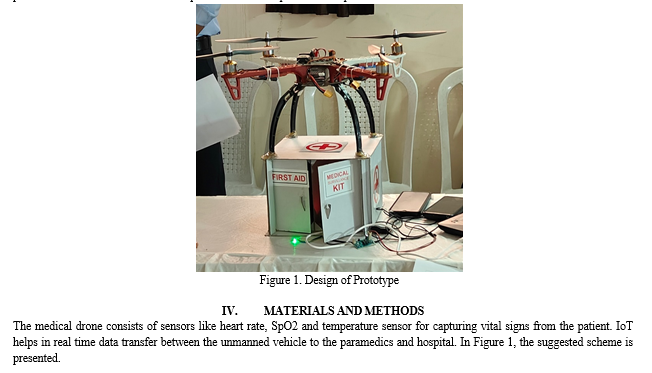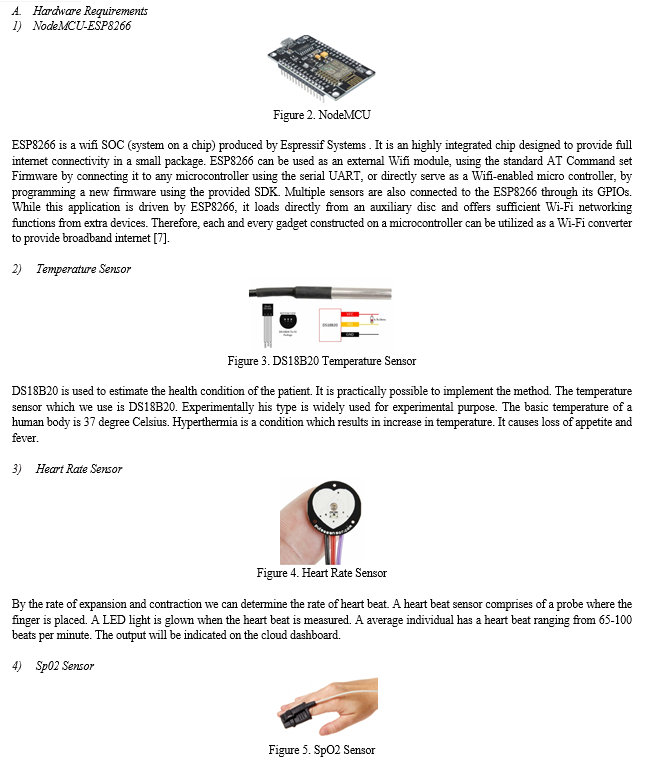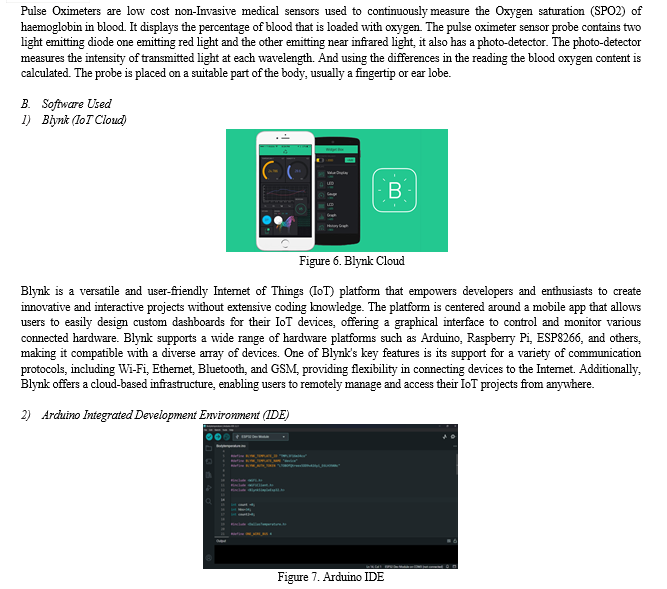Ijraset Journal For Research in Applied Science and Engineering Technology
- Home / Ijraset
- On This Page
- Abstract
- Introduction
- Conclusion
- References
- Copyright
Medical Drone in Emergency Healthcare
Authors: Dr. P A. Tijare, Shreyash Salwe, Prathmesh Shinde, Prachi Sharma, Avantika Raut
DOI Link: https://doi.org/10.22214/ijraset.2024.60523
Certificate: View Certificate
Abstract
This paper proposes a concept for an air ambulance based on drones. The drone ambulance would be a small, lightweight vehicle that could be deployed quickly and easily to reach accident victims in remote or difficult-to-access areas. The drone ambulance would be equipped with medical supplies and a first responder, who would be able to stabilize the patient and transport them to a hospital. The drone ambulance would have several advantages over traditional air ambulances. It would be much faster and more maneuverable, making it ideal for reaching victims in remote areas. It would also be much cheaper to operate, making it more affordable for rural and remote communities. The drone ambulance is still in the conceptual stage, but it has the potential to revolutionize emergency medical services. It could save lives by providing rapid and efficient transportation to accident victims. In this an IoT-based system for heart rate monitoring, temperature and SpO2 (blood oxygen saturation) sensing is designed to collect and transmit crucial patient data to emergency services. The system incorporates wearable devices equipped with sensors that continuously monitor the user\'s heart rate, temperature and SpO2 levels. These devices are connected to the Internet of Things (IoT) infrastructure, allowing real-time data transmission to a centralized platform.
Introduction
I. INTRODUCTION
In recent years, advancements in unmanned aerial vehicle (UAV) technology have opened up new possibilities in various fields, including healthcare. One of the most promising applications is the use of medical drones in emergency healthcare. This project aims to explore and implement the integration of medical drones to enhance the efficiency and effectiveness of emergency medical services. Emergency healthcare often faces challenges such as time-sensitive situations, limited accessibility, and the need for rapid response. Medical drones present a revolutionary solution by providing a swift and flexible means of transporting essential medical supplies, diagnostic tools, and even organ transplants to remote or inaccessible locations. This technology has the potential to significantly reduce response times and improve patient outcomes during critical situations. Investigate the logistics of using medical drones to transport essential supplies (e.g., medications, blood samples, first aid kits) to remote or disaster-stricken areas. Develop a real-time tracking and monitoring system for the transported medical supplies. Explore the feasibility of deploying medical drones as first responders to deliver emergency medical kits or automated external defibrillators (AEDs) to accident sites or locations with limited accessibility. Integrate communication systems to establish a seamless connection between the medical drone and emergency responders. Investigate the potential of medical drones in transporting organs for transplantation and blood products for emergency transfusions. Implement safety measures and protocols to ensure the integrity of transported organs and blood products. Address legal and regulatory challenges associated with the use of medical drones in healthcare, ensuring compliance with aviation and healthcare regulations. Explore ethical considerations related to patient privacy, consent, and community acceptance.
II. LITERATURE REVIEW
With the increasing population, the occurrence of an accident or a calamity is habitual. In addition to that traffic and other barriers make it tough for the rescue team like an ambulance or military unit to help provide them with timely treatment and care [1]. To overcome this, a drone with inbuilt sensors to capture and monitor the patient’s data has been built. The proposed system has many advantages like air transport hence can reach inaccessible locations faster skipping the traffic and can have a cloud backup for storage and retrieval of patient’s data.
This unmanned vehicle can send the facts and figures to the healthcare professionals for example to the hospital staff and paramedics to provide urgent medical care [2]. The information recorded is mostly the vitals of the patient such as respiration rate, heart rate, body temperature, SpO2, and blood glucose level [3]. Technological advancements like IoT (Internet of Things), embedded systems, MEMS (micro electrical mechanical systems), and ThingSpeak provide tracking and monitoring the vital signs without human intervention. To visualize and analyse the real-time data transfer from the sensors presents on the drones to the healthcare providers a cloud-based IoT application called ThingSpeak is used.
To protect the data from potential hackers, an OTP (One time password) has been delivered [4]. After the data is compiled and analysed, the physicians and doctors remotely control the unmanned vehicle to provide immediate medical assistance like pinpointing the correct position for placing defibrillator pads. Josephin et al. (2018) proposed an air ambulance prototype that can reach patients quicker than conventional ambulances, saving time and measuring various health parameters. This system uses a global positioning system and ZIGBEE to transmit the patient’s data to nearby hospitals and paramedics [5]. Braun et al. (2019) developed a drone mechanism that has the remarkable ability of delivering major life medical services to remote regions and territories were restricted access due to environmental or malicious disasters. The communication channels of drone-based national healthcare transport need the necessity for international agreement among public and army medical groups to utilize the existing economic materials as well as unique innovative technology for greater rescuing potential [6].
III. PROPOSED WORK AND OBJECTIVE
By considering and analyzing the problems in hilly areas, as there could be a vulnerable situation in which medical facilities does not easily accessible,by considering such vulnerable condition we have proposed this drone which we named “Medical drone in Emergency healthcare” . Hilly areas frequently encounter obstacles in accessing medical facilities promptly, leading to critical delays in patient treatment. The geographical terrain hampers conventional transportation methods, exacerbating the urgency of medical emergencies. Moreover, the time-consuming process of transporting patients and collecting vital health data further compounds the challenges, underscoring the need for innovative solutions to streamline healthcare delivery in such regions.
Our proposed model is of drone, which will encompasses three parameters having three sensors which are SpO2,Heart rate,Temperature sensors whereas SpO2 sensor will keep track on oxygen level, Temperature sensor will measures the temperature and Heart Rate sensor will captures the heart rate of the patient’s body. All those sensors will be enclosed in a medical kit. These sensors enable real-time monitoring of vital health parameters crucial for effective medical intervention. They will be handy and their application will be similar to those which usually doctor used at every medical center like plug in the clips into the fingers, wrap a band for temperature measuring and touching the sensor to obtain the heart rate ;in a more vulnerable situation,we will need an operator.
Blynk Cloud technology is used to transmit the measured health parameters. This information will help the doctors to take treat the patients in time. The intimated health parameters will help to track the patients current condition.



Arduino is open source electronics platform that uses simple hardware and software to make it easy to use. Arduino boards can take inputs- such as light from a sensor, finger on button, etc. and convert them to outputs- such as turning on an LED, triggering a motor, or publishing anything online. The Arduino Integrated Development Environment (IDE) is a C and C++ based cross platform application (for Windows, Mac OS, and Linux). It’s used to write and upload programs to Arduino-compatible boards, as well as other vendor development boards with the support of third-party cores. The Arduino IDE uses unique rules of code organization to support the languages C and C++.
V. IMPLEMENTATION
Implementing a medical drone for emergency healthcare using a NodeMCU ESP8266 microcontroller and connecting it with sensors for SpO2, heart rate, and temperature is a fascinating project. Here's a basic outline of how you can approach this:
- We have implemented NodeMCU ESP8266 microcontroller, basically this acts supportive framework data acquisition and communication with the Blynk cloud, whereas SpO2 Sensor helps to measure oxygen saturation in the blood, Heart Rate Sensor measures the heart rate of the patient and Temperature Sensor measures the body temperature of the patient.
- We have Connected the SpO2, heart rate, and temperature sensors to the NodeMCU ESP8266 microcontroller following their respective datasheets and pin configurations .Additionaly we have used libraries (Dallas temperature, BynkSimpleEsp2,WiFiClient) to interface with each sensor and retrieve the sensor readings.
- We have created an account on the Blynk platform (https://blynk.io/) and created project as well as generated an authentication token for our project moreover added appropriate widgets in the Blynk app to display the sensor data (e.g., Value Display for SpO2, heart rate, and temperature).
- We have written a firmware for the NodeMCU ESP8266 microcontroller using the Arduino IDE and included libraries for the ESP8266, Blynk, SpO2 Sensor and Heart Rate Sensor. We have Initialized the sensors , configure them to read data periodically and Connected the NodeMCU ESP8266 to the Blynk cloud using the generated authentication token. Moreover send the sensor readings to the Blynk cloud periodically.Lastly ensured error handling and robustness in the code to handle network issues and sensor failures.
- We have tested the entire setup thoroughly in a controlled environment to ensure that the sensor readings are accurate and reliable, calibrated the sensors if necessary to improve accuracy,Conducted real-world tests to simulate emergency healthcare scenarios and evaluate the performance of the medical drone.

VI. RESULT
The development of the quadcopter was done and a med box was installed at the base of the quadcopter. The drone was able to fly within the specified range. The real time health parameters of the patient which are transmitted by ESP8266 module are observed in the Blynk Cloud Software and those results and graphs are presented.
The integration of a medical drone equipped with a NodeMCU ESP8266 microcontroller, along with SpO2, heart rate, and temperature sensors transmitting data to the Blynk cloud, offers promising results for emergency healthcare. The use of a medical drone enables rapid response times to emergency situations, providing healthcare professionals with immediate access to critical patient health data. Doctors can remotely monitor vital signs such as SpO2 levels, heart rate, and temperature in real-time through the Blynk cloud, allowing for timely interventions and treatment adjustments. In remote or inaccessible areas where traditional medical facilities are lacking, medical drones can facilitate the delivery of essential healthcare services, potentially saving lives. By streamlining data transmission and enabling remote monitoring, the medical drone optimizes the use of healthcare resources, allowing medical personnel to focus on critical cases while still providing effective care. Timely access to vital health data empowers healthcare providers to make informed decisions, leading to better patient outcomes and increased chances of survival in emergency situations.
Overall, the use of a medical drone integrated with NodeMCU ESP8266 microcontroller and sensor technology, coupled with data transmission to the Blynk cloud, holds significant potential for transforming emergency healthcare delivery by providing timely access to critical patient health data, particularly in remote or challenging environments.

Conclusion
In conclusion, the implementation of a medical drone equipped with a NodeMCU ESP8266 microcontroller connected to SpO2, heart rate, and temperature sensors, transmitting data to the Blynk cloud, presents a promising solution for emergency healthcare. The medical drone provides a swift response to emergency situations, delivering vital health data from the patient directly to healthcare providers without delays. Healthcare professionals can remotely monitor the patient\'s SpO2 levels, heart rate, and temperature in real-time through the Blynk app, enabling timely interventions and treatment adjustments. In remote or inaccessible areas where traditional medical facilities are scarce, the medical drone can bridge the gap by providing essential healthcare services. By streamlining the data transmission process and enabling remote monitoring, the medical drone optimizes the utilization of healthcare resources, allowing medical personnel to focus on critical cases. With timely access to vital health data, doctors can make informed decisions, leading to better patient outcomes and potentially saving lives in emergency situations.
References
[1] Albert Apotele Nyaaba, Matthew Ayamga 2021 Intricacies of medical drones in healthcare delivery: Implications for Africa Technology in Society. 66(101624) 1-8. [2] Matinrad N., Reuter-Oppermann M 2022 A review on initiatives for the management of daily medical emergencies prior to the arrival of emergency medical services. Cent Eur J Oper Res 30 251–302. [3] Shengqiang Jiang, Yong Jin and Kaijian Xia 2021 Drone Assisted Robust Emergency Service Management for Elderly Chronic Disease Journal of Healthcare Engineering (2021) 01-12. [4] Bethanney Janney J, Sindu Divakaran, Kezia George, Chandana H, Caroline Chriselda L 2020 Wearable EMG Sensor for Gait Rehabilitation using IoT Int. J. Res. Pharm. Sci.11(4) 2675- 2680. [5] Josephin Arockia Dhivya, Hemalatha, Thamizhvani, Josline Elsa, Bincy Babu, Chandrasekaran 2018 Medical Drone – A Life Saver in Emergency Situations International Journal of Engineering & Technology 7(2.25) 14-16. [6] Braun J, Gertz S D, Furer A 2019 The promising future of drones in prehospital medical care and its application to battlefield medicine Journal of Trauma and Acute Care Surgery 87(1S) S28– S34. [7] Scott Judy and Carlton Scott 2017 Drone Delivery Models for Healthcare, 50th Hawaii International Conference on System Sciences HICSS 3297- 3304.
Copyright
Copyright © 2024 Dr. P A. Tijare, Shreyash Salwe, Prathmesh Shinde, Prachi Sharma, Avantika Raut. This is an open access article distributed under the Creative Commons Attribution License, which permits unrestricted use, distribution, and reproduction in any medium, provided the original work is properly cited.

Download Paper
Paper Id : IJRASET60523
Publish Date : 2024-04-17
ISSN : 2321-9653
Publisher Name : IJRASET
DOI Link : Click Here
 Submit Paper Online
Submit Paper Online

